Abstract
The world is transitioning towards a net zero emissions future and solar energy is at the forefront of the transition. The land use requirements to install solar farms present a barrier for the industry as population density increases and land prices rise. Floating photovoltaics (FPV) addresses this issue by installing solar photovoltaics (PV) on bodies of water. Globally, installed FPV is increasing and becoming a viable option for many countries. A 1% coverage of global reservoirs with FPV would have a potential capacity of 404GWp benign power production. There are numerous advantages to FPV compared to ground mounted PV (GPV), which are discussed in this review. The major gap in research is the impact FPV has on water quality and living organisms in the bodies of water. This review paper examines the most recent research around FPV, analyzing the benefits, downfalls, and future. The review provides more insight into FPV in terms of varying water bodies that can be used, system efficiency, global potential, and potential for coupling FPV with other technologies.
1. Introduction
As the world population continues to grow, the energy demand is also increasing, causing an increase in use of fossil fuels, which emit greenhouse gases [1]. As climate change continues to worsen, the world is looking at ways to reduce greenhouse gas emissions [2,3]. The world is facing a climate crisis. The International Energy Agency (IEA) reported that in order for the world to reach the goal of net zero emissions by 2050 there will have to be an annual average solar energy generation growth of 24% [4]. In 2020, solar generation increased 23%, resulting in the IEA categorising solar photovoltaics (PV) as ’more effort needed’ [4].
Solar PV is expected to be a leading technology to power the world in the future [5]. The price of PV has reduced drastically, reaching a price similar to that of conventional energy sources [6,7]. The IEA stated that PV has become the lowest-cost electricity source in history [4]. While installed PV is set to continue growing, the large scale ground-mounted photovoltaic (GPV) farms are running into issues of finding land to install on [8]. A 1MW PV farm needs approximately 15,000 m2 of land [9]. With large land requirements and rising land prices it is becoming increasingly difficult to purchase land for a PV farm [10]. Other challenges faced by PV installations are cooling of the panels and keeping them free of dust in order to increase energy efficiency [11]. A solution to this challenge is placing PV on bodies of water such as ponds, lakes, reservoirs, oceans, canals, lagoons, waste water treatment plants, or irrigation ponds [12]. The placing of PV panels on top of bodies of water is called floating photovoltaics (FPV) or floatovoltaics. Countries that are facing challenges with land availability for PV farms are looking towards the potential of FPV [13].
The aim of this review paper is to analyze the status of FPV, along with the benefits and drawbacks of the new technology, with a section looking at submerged photovoltaics (SPV). This report is unique as it observes the current status of FPV and the knowledge gaps that require investigation and a solution. There is a focus on the challenges that GPV faces and how FPV addresses some of these challenges. FPV is a relatively new technology with the first plant installed in 2007 in Japan [14]. Table 1 shows an overview of the major milestones within the FPV industry. The graph in Figure 1 shows the installed FPV capacity from 2007 to 2018, and it is clear that FPV is growing rapidly.

Table 1.
FPV early development milestones.Adapted with permission from [14]. 2019, World Bank. [14].
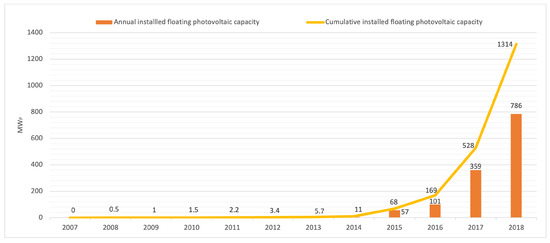
Figure 1.
Global FPV installed capacity. Adapted with permission from [14]. 2019, World Bank.
Globally, installed FPV capacity is seen to be doubling each year and is predicted to continue doubling [15]. Figure 2 shows a global breakdown of installed FPV as of 2020, the majority being located in China. The cost of FPV is higher than GPV currently with a project break-even cost 4–8% higher [16]. There is massive global growth in this sector but minimal knowledge about the possible negative impacts of FPV, making this an essential and timely review.
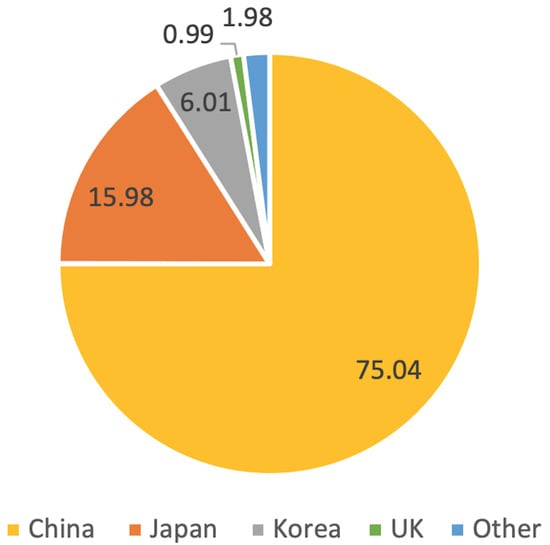
Figure 2.
Globally installed FPV as of 2021. Adapted with permission from [17]. 2021, Ma.
2. Methods
In order to complete the aims of this review paper, an in-depth analysis of FPV academic papers and industry reports was completed. Google scholar, Mendeley, and the University of Exeter library were used to find relevant papers. All cited papers have been peer reviewed and published; this is important to ensure correct information is being used. To find relevant papers, the following keywords were used: FPV, PV cooling effect, FPV hybrid with hydroelectric power plants (HPP), floatovoltaics, SPV, and marine PV. Papers from 2018 and later were considered as only the most recent research was of interest. In certain instances, older papers were looked at in order to understand the early stages of FPV. Each paper was organised in an Excel table containing its title and key information. They were organised into categories to be compared and synthesised. A flowchart of the review process is seen in Figure 3.
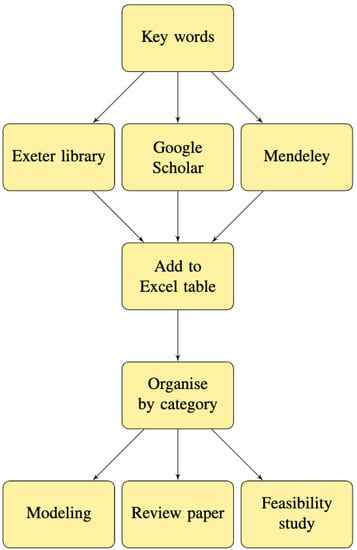
Figure 3.
Flowchart of review process.
3. Technology Overview
A general FPV system consists of PV panels and system installed atop a floating structure that is anchored to the ground as seen in Figure 4.
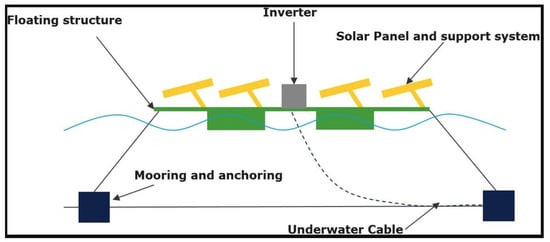
Figure 4.
FPV components Reprinted wiht permission from [18]. 2020, Oliveira-Pinto.
3.1. Floating Structure
A pontoon structure is used to keep the system floating in the water [12]. The pontoons are formed by attaching floats together in order to hold the weight of the structure on top of the water [12,18]. The majority of floats used in the industry are made out of high-density polyethylene (HDPE) due to it being UV resistant, corrosion resistant, maintenance free, recyclable and having good tensile strength [12]. Another material used for floats, though less common, is glass fibre reinforced plastic [12]. These systems generally have a set panel inclination that is not easily adjusted once installed [18]. A benefit of the floating structures is that they are easy to decommission compared to a GPV system [19]. Other floating structure options include galvanized steel platforms and one or two axis tracking platforms [18].
3.2. PV Module
The commonly used module type for FPV installations is crystalline silicon [12]. Crystalline modules work well in fresh water environments, but as the sector looks toward marine environments, modules will need to be designed to withstand the salty environment. Therefore, standard metal frames will need to be replaced with an alternative material [12]. There is potential to also use second generation CdTe [20,21,22], a-Si, or CIGS [23], but there has been limited investigation with these technologies. Third-generation PV is not considered yet for FPV due to the lack of maturity [24,25,26,27].
3.3. Mooring
The mooring system of an FPV installation is required to hold the system in place, avoiding overturning or floating away [12]. The system can be moored with anchors on the ground of the body of water, or alternatively, directly to shore [18]. Nylon ropes are often used as the mooring lines and allow movement of the system for changes in water depth and blowing wind [28].
3.4. Cables
Underwater cables can be used to transport the generated electricity to an onshore substation [18]. It is also common to keep the cables above the water [12].
3.5. Installation
The installation process for FPV is often easier than that for GPV, as long as the anchoring and mooring system is not complicated [14]. The installation does not require heavy equipment and the system is usually assembled on land and then transferred onto the body of water where it can be towed to the site [14,29]. Lightsource, a company in the United Kingdom, used a ramp to roll FPV into the water [30]. The installation can be seen in Figure 5.
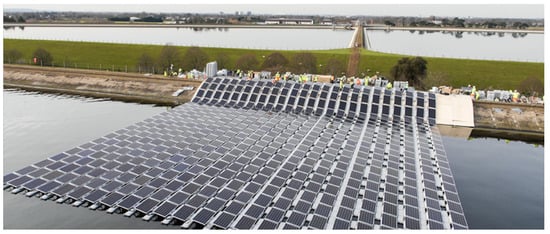
Figure 5.
Array deployment using a ramp. Reprinted with permission from [14]. 2019, World Bank.
3.6. Location
In order to choose a suitable FPV location, there is a list of criteria that must be taken into consideration. Table 2 breaks down the key criteria that must be analysed before selecting a location to install FPV.

Table 2.
Site suitability. Adapted with permission from [14]. 2019, World Bank.
4. Results and Discussion
4.1. Cooling Effect
PV modules are negatively affected by high temperatures as high temperatures decrease the performance, energy output, efficiency, and life span of the modules [11]. The most critical factor affecting a PV module’s efficiency is module temperature [31]. An increased surface temperature of a module results in sunlight being converted into heat rather than output power [31]. There has been extensive research into cooling methods for PV modules in order to increase the efficiency when exposed to hot temperatures [32]. When PV modules are placed on bodies of water, they experience a cooling effect that increases their efficiency compared to a GPV system [33]. A paper comparing the cooling effects on FPV in the Netherlands (temperate maritime climate) versus Singapore (tropical climate) found that Singapore had a 6% increase in annual energy yield while the Netherlands had a 3% increase [34]. Another paper investigating the performance of FPV in the tropics found an up to 10% increase in annual energy yield due to the cooling effect [13]. A study in Visakhapatnam, India, found a 1.5–3% increase in energy production for FPV compared to GPV [35]. Another study in India found a 2.5–3% increase between FPV and GPV [36]. Brazillian reservoirs were analysed in a study and found to have a 12.5% increase in efficiency for FPV because of the cooling effect [37]. The World Bank also found increased efficiency varying between 5% and 10% for different climatic regions [14]. The cooling effect due to the cool air flowing under the PV modules is a key advantage of installing an FPV system over a GPV system.
4.2. Humidity
Another effect of installation on water is an increase in humidity for the modules [38]. FPV modules experience higher humidity compared to GPV modules [38]. An increase in humidity around a module can affect the atmosphere and cause the module temperature to increase, thereby decreasing the performance of the module [38].
4.3. Water Evaporation
Studies have shown that FPV is capable of significantly decreasing water evaporation [19,39]. This can be important for coupling FPV with HPP, which will be discussed in Section 4.7. It is also increasingly important for countries that are dealing with water shortages [40,41]. Water-scarce regions in central and southern Asia were concluded to benefit greatly when FPV was installed [41,42]. A study found that a 1MW FPV system in Visakhapatnam, India, would reduce water evaporation and save 42-million litres of water [35]. A study looked at the water evaporation reduction, economic feasibility, energy generation, and environmental impact of installing FPV on five main reservoirs lakes in Iran [43]. By covering 10% of the five main reservoir lakes with FPV, enough water would be saved from evaporation to meet the domestic water demands of a city with 1-million inhabitants. The study states that FPV would be beneficial for Iran as it is facing an energy and water crisis [43]. The reduction of water evaporation is a benefit of FPV.
4.4. Impact on Water Quality
FPV is a growing sector that only began to boom recently. As a result, there is minimal research on the impact of FPV on water quality. The impact on water quality is noted to be the greatest threat of FPV. A study conducted by Exley et al. reported that FPV operators stated there was no impact on water quality, but only 15% are monitoring and analysing the water quality while the majority are using only visual inspection [44]. The paper goes on to explain that nine ecosystem services could be affected by the installation of FPV [44]. A study using two adjacent agricultural ponds, one covered with FPV and one open as a control, found that there were no negative effects on water quality associated with the FPV [39]. The study found improved concentrations of cholorophyll and nitrate, as well as a 60% decrease in water evaporation [39]. Multiple papers concluded that a positive impact FPV has on water quality is the reduction of algae growth [19,45]. The percentage of FPV cover on a body of water will determine the system’s impact on algae growth. A study investigating the impact of FPV on water quality found that FPV covering a small amount of a reservoir was not enough to reduce algae blooms [46]. A main concern reported in research around FPV impact on water quality is that there has not been enough studies and modeling to conclude that there will not be negative effects. Table 3 shows a summary of the potential opportunities and threats of FPV on water quality.

Table 3.
Potential opportunities and threats of FPV on water quality. Reprinted with permission from [44]. 2021, Exley.
4.5. Land Use
Countries with a high population density are facing the issue of finding land that can be used for solar PV farms [47]. FPV addresses this issue as it can be placed on surfaces of bodies of water that would otherwise go unused [45]. FPV systems can be installed on ponds, lakes, reservoirs, oceans, canals, lagoons, waste water treatment plants, or irrigation ponds. FPV can also be beneficial for small island communities that lack ample land space [48]. The cost of installing FPV is often lower than GPV because land does not have to be purchased or approved [41]. A techno-economic case study in Islamabad found that a GPV system would have a return of over 15 years compared to a floating system on NUST lake, an urban lake, which would have a return of 5.37 years [49]. Not having to pay for land for the installation in Islamabad makes the FPV system more feasible than a GPV system [49]. The pay back is also affected by the increase in electrical output and lower cleaning cost for FPV, which will be discussed later in the paper. Chowdhury et al. examined how the use of FPV in their home country, Bangladesh, can be very beneficial due to the high population density [50].
4.6. Shading and Soiling
FPV does not often suffer in performance from shading of the surroundings as it is located on a flat area [13]. The lack of shading is a benefit of FPV.
Soiling losses are a result of deposited dust accumulating on PV systems and are a major issue that reduces the power generation of a PV system [51,52,53,54]. Soiling losses that reduced power production by 3% to 4% in 2018 caused a revenue loss of EUR 3–5 billion due to the reduced power production [55]. By 2023, it is assumed that soiling losses will result in a revenue loss of EUR 4–7 billion. With an expected global solar energy generation of 7200 TWh by 2040, it is becoming increasingly important to reduce soiling losses. The common solution to reduce soiling losses is to use anti-soiling coatings on the PV system [56,57]. FPV is another solution that can reduce soiling losses. By employing FPV, the panels are less likely to undergo soiling as water bodies are often less dusty than the arid regions in which GPV are usually installed [13]. If soiling does occur, it is easier to clean FPV than GPV systems as there is water on site that can be used to clean the modules.
4.7. FPV Hybrid with (HPP)
Hydropower is the leading renewable source of electricity generating more electricity than all other renewable sources combined [58]. There are over 9000 HPP reservoirs globally [59], covering a surface of around 265,700 km2 [60]. These reservoirs are being researched for the potential of installing FPV [60]. The relatively new concept of coupling FPV with HPP is being explored and feasibility studies have been conducted in order to determine the advantages and disadvantages of the coupling [61]. Figure 6 shows a schematic of what a general HPP FPV hybrid system would look like. The main benefits of coupling HPP and FPV are water savings, water quality, grid connection, cooling, power fluctuation reduction, no land occupancy, energy storage, and radiation balance [61,62].
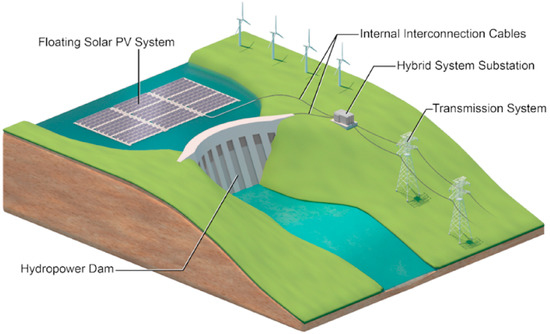
Figure 6.
FPV hybrid system with HPP schematic. Reprinted with permission from [62]. 2020, Lee.
As stated in Section 4.3, FPV is found to reduce water evaporation, which therefore would increase hydropower efficiency [61,62,63]. A 1 MW installation of FPV can save between 700 m2 and 10,000 m2 of water annually [63]. Section 4.4 reviewed papers and concluded that FPV reduced algal growth in the water, which improves the water quality. Improved water quality is another benefit of coupling HPP with FPV.
Grid connection is an important benefit of coupling as it will save costs in the installation of FPV [61,63]. It is beneficial to install FPV systems where grid connections already exist.
A challenge with PV, and other renewable energy sources, is their intermittency [64]. The variable power generation is holding solar back from growing in the energy market [64]. Having FPV coupled with HPP helps with this issue as they can be used complementarily [62]. During the day when solar irradiance is high, the reservoir can hold water to be used when the FPV is not generating electricity [62]. On an annual basis, depending on the location, solar potential is often high while HPP has reduced power due to less water flow [61]. In 2020, a study was conducted by Yanlau Zhou that looked at how an FPV hybrid system with HPP affects the water, food, and energy nexus [65]. A model was created to maximize the water storage and power output of the hybrid system and concluded that the system would improve the synergistic benefit between water, energy, and food [65].
A study performed by the European Commission Joint Research Centre conducted an assessment on installing FPV on HPP reservoirs in Africa [66]. The study examined 146 of the largest HPP in Africa and concluded that installing FPV covering 1% of reservoirs would double the power capacity of HPP and increase electrical output by 58% [66]. Numerous African nations rely on HPP as their electricity source and increasing droughts in the continent affect the HPP power generation [66]. FPV was concluded to save water evaporation in the HPP reservoirs they are placed on, which is seen as a major benefit in Africa [66]. A study completed at Macquarie University conducted a feasibility analysis of installing FPV on HPP in Australia [67]. The paper examined the four largest HPP in New South Wales, Australia, and found that the total power capacity of the HPP can be met using FPV [67]. A techno-economic analysis was completed for an FPV HPP hybrid system in Bangladesh and concluded that the integration would be beneficial for the country [68]. The system would create clean energy, reduce water evaporation, have a return of nine years, and help reach sustainable development goals [68]. A paper written from Air University in Islamabad examined coupling FPV with a newly proposed HPP project in Pakistan [69]. The paper concluded that it would be prudent to combine the systems because it would generate significantly more electricity and benefit from sharing the transmission and distribution system [69]. It also notes that the FPV system will generate 10% more electrical output compared to a GPV system in the same location [69]. In recent years, Brazil has decreased its HPP generation and relied more on thermoelectric power plants, which has increased greenhouse gas emissions [70]. A paper by Naidion Motta Silverio looked at the use of FPV with existing HPP in the Sao Francisco River basin because this region has suffered from droughts, therefore, increasing its need for thermoelectric power plants [70]. Installing FPV on the existing HPP would be beneficial and is seen to compliment the seasonal flow of the river [70].
The first HPP FPV hybrid system was installed on the Alto Rabagao reservoir in Portugal in 2017, shown in Figure 7 [71]. The benefits of coupling HPP with an FPV system are clear in the academic papers and the potential for coupling systems is seen in countries around the world.
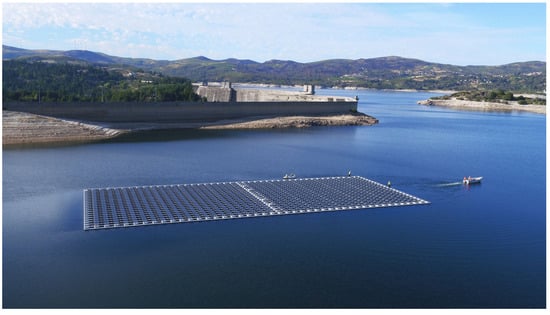
Figure 7.
First HPP FPV hybrid system installed on Alto Rabagao reservoir, Portugal in 2017 (41.7° N, 7.9° W). Reprinted with permission from [14]. 2019, World Bank.
4.8. Irrigation Ponds
A possible location to install FPV is on irrigation ponds. Placement on agricultural irrigation ponds can be beneficial to providing farms with electricity [39]. A 305 kW FPV that covers 45% of an agricultural irrigation pond was installed in Brazil [71]. In Japan, the majority of installed FPV farms are on irrigation ponds [9]. The installed FPV can provide farms with electricity while also reducing water evaporation from the ponds [39].
4.9. Fresh Water vs. Marine Water
The majority of FPV research and installations have been in fresh water and this approach cannot simply be transferred to marine water installations [72]. As noted in Section 3.2, commonly used PV modules are not designed to be located in salty environments and the salty air will affect the metal frame. Further, FPV systems installed in a marine environment will be exposed to tides, currents, stronger winds, and waves [72]. The more diverse ecology in marine environments must be taken into consideration as it can cause biofouling and affect coral systems [72]. There is also the potential for artificial reefs to grow on an FPV installation and to combine FPV with other marine energy devices. The pontoon structures used for marine environments vary from those typically used for fresh water installations as seen in Figure 8, Figure 9 and Figure 10. Figure 8 shows Swimsol’s floating SolarSea located in the Maldives on individual two meter high wired frames with floats attached [73]. The wire frames allow the wave, wind, and current forces to pass through the structure, as oppose to solid pontoons which take on the full impact of the forces [73]. Figure 9 displays connected rectangular pontoon modules for a deployment in the Dutch North Sea. Figure 10 displays an innovative design by Ocean Sun that can be used in near-shore, sheltered, marine environments [74]. Overall, there is potential for FPV in marine environments. However, there are more challenges to overcome compared to fresh water installations and there exist large knowledge gaps in research.
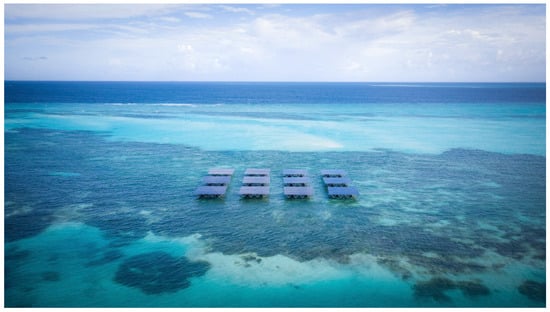
Figure 8.
Marine FPV installation in the Maldives (5.23° N and 4.49° N). Reprinted with permission from [73].
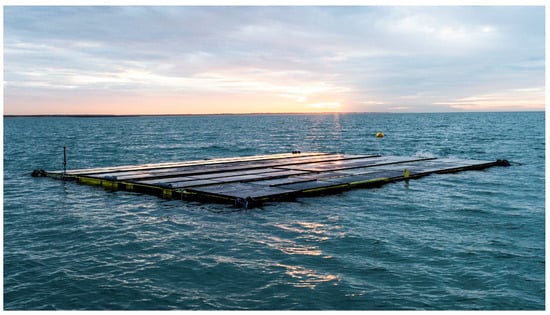
Figure 9.
Marine FPV installation in the Dutch North Sea (56° N, 3° E). Reprinted with permission from [75].
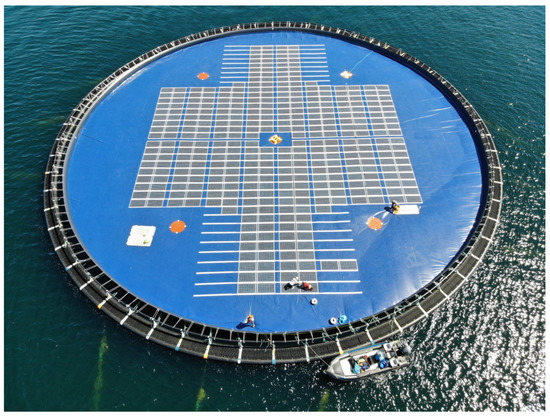
Figure 10.
Ocean Sun floating solar system in Norway (60.1° N, 5.2° E). Reprinted with permission from [76].
4.10. High Altitude
Placing FPV in high mountain lakes has the benefit of the snow-covered mountains having high albedo and reflecting the solar rays [77]. The potential of FPV on mountain lakes has been examined in Switzerland where a 448 kWp FPV system was installed on Lac des Toules at an altitude of 1800 m [77,78,79]. Figure 11 shows the system on Lac des Toules that was installed in 2019 [78]. The snow-covered ground can increase the energy yield by 10% [79]. A benefit of the increased production in winter months is in alignment with higher energy use in Switzerland due to the heating of buildings [79]. A study found that the total potential for high-altitude FPV in Switzerland could meet the country’s energy demand while also reducing its carbon emissions [80].

Figure 11.
Lac des Toules high-altitude FPV installation (45.9° N, 7.2° E) Reprinted with permission from [78].
4.11. Desalination
The option of using FPV for desalination plants has been researched. Desalination is the process of removing salts and minerals from seawater to obtain fresh water [81]. Desalination takes a significant amount of energy and is often powered by fossil fuels. Using solar energy for desalination would require a large area to produce enough energy according to a study conducted in California [81]. For this reason, the potential of using FPV for desalination is not yet feasible. It is an area of continuing research as desalination plants are located by water making FPV a great solution to render the process more sustainable.
4.12. Electric Vessels
The concept of using foldable floating solar arrays to charge electric vessels was explored in Mayank Tiwari’s paper [82]. The foldable floating solar arrays use the concept of FPV but are able to be easily taken on and off of the water surface [82]. The proposed system could be key in transitioning water vessels toward being electric powered [82].
4.13. Electrical Cabling
With increased installation of subsea electrical cables for marine renewables, there is growing concern that the electromagnetic fields (EMFs) can affect marine life [83]. The EMFs could affect animals that use magnetic fields to navigate and communicate [83]. The EMFs could also affect migrating fish [83]. More research is warranted in order to understand the risks and the potential effects should be considered when installing FPV in the meantime.
4.14. Submerged Photovoltaic (SPV)
There has been research on the potential of SPV. If viable, SPV could be used for sensors, autonomous power systems, and vehicles for both commercial and defence applications [84]. Research conducted in 1990 concluded that solar energy decreases as the depth of water increases [85]. The research showed that the decrease in solar energy with water depth is not an exponential trend [85]. The amount of solar energy absorbed within the first centimetre of water is 27% and 70% at a water depth of 3 m [85]. Using the derived mathematical equation at 100 m of water depth the remaining solar energy would only be 0.25% of the total transmitted solar energy [85]. Studies have stated that there is potential for the use of SPV for underwater applications [86]. The use of high-bandgap-InGaP cells are seen to perform better than silicon cells when submerged [86]. Another paper looked at comparing amorphous cells to monocrystalline cells and found that amorphous cells performed better overall [84]. Further, another investigation found that dye-sensitised cells perform better than mono-crystalline and amorphous cells when placed underwater [87]. A benefit of SPV is the cooling effect from the water, limited soiling losses or need for cleaning, and reduced land constraints [84]. One study performed in Italy examined the potential of using SPV in swimming pools [88]. The study discussed the potential of using the power from the SPV to heat the swimming pool [88]. Rendered examples of SPV being used for swimming can be seen in Figure 12 and Figure 13.
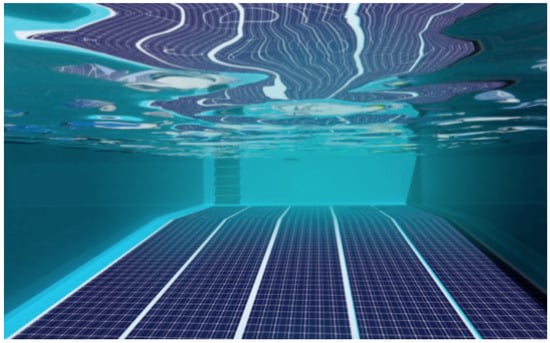
Figure 12.
SPV used at bottom of pool. Reprinted with permission from [88].
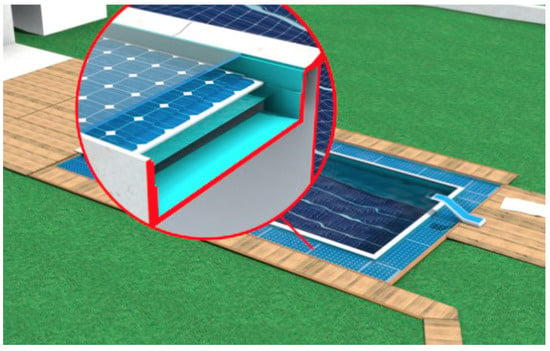
Figure 13.
SPV integrated with pool skimmer edge. Reprinted with permission from [88].
5. Perspective
The global potential for FPV has been calculated in various studies. A study by Lee et al. examined 279,068 global HPP reservoirs and calculated a 3.0 TW potential [62]. Farfan et al. found a 4.4 TW potential looking at global HPP reservoirs [60]. A novel study investigating the potential of FPV in North America concluded that there are 24,419 bodies of water, all human-made, that are suitable for FPV installations [89]. If 27% of these bodies of water were covered with FPV it would supply 10% of the country’s electricity demand [89]. Many of these installations would see multiple benefits in areas with high land costs, water scarcity, and increasing electricity prices [89]. Currently, there are fewer than 10 installments in North America [90]. The Solar Energy Institute of Singapore looked at global potential on human-made reservoirs with FPV covering 1%, 5%, and 10% of the reservoirs’ area [14]. The results are seen in Table 4.

Table 4.
Reservoir Capacity. Adapted with permission from [14]. 2019, World Bank.
Given the research conducted to date on FPV, it is shown that there is large potential for FPV globally. The world’s first development guidelines for FPV were released in March 2021 by Det Norske Veritas (DNV) [91]. The document contains guidelines, recommendations, and requirements for the design, development, operation, and decommissioning of FPV installation. In areas with high population density, where land is scarce and expensive, FPV seems to be a great solution for obtaining clean energy. It is also beneficial for water-scarce countries as it will reduce water evaporation from reservoirs that hold water for human use. Through research into coupling FPV with HPP it seems to be a great solution for countries that already have HPPs installed. The reservoirs for HPPs provide ample space for FPV and are already connected to the grid, making it simple to transfer the solar energy onto the grid. With the development of FPV occurring at such a rapid rate, it is resulting in knowledge gaps, especially around the impacts on water quality. This is an area that needs more research and analysis because if FPV has a large negative impact on water quality and habitational water ecosystems then it is not a solution to help move towards a more sustainable future. GPV is currently a leading renewable energy technology, but research is showing that FPV could be a solution to the issues of GPV. Table 5 shows a comparison of some key differences between GPV and FPV.

Table 5.
Advantages and disadvantages of FPV and GPV.
6. Conclusions
An in-depth review of the status of FPV has been conducted. The review concludes that while there are many benefits of FPV, there are also disadvantages that are known, and some disadvantages that may have not yet been discovered. Advantages of FPV installation over a GPV system include cooling due to the proximity to water, no land use requirements, reduced water evaporation, reduced soiling, reduced algal blooms, and easy installation. Known disadvantages include humidity effects on the PV modules and unknown effects on water quality. Sites best suited for FPV are human-made bodies of water including reservoirs, irrigation ponds, and industrial ponds. There is great potential for FPV to be integrated in a hybrid system with reservoirs of HPPs. The already existing grid access and reduced water evaporation are the two main advantages of a hybrid system. Countries with high population densities are looking toward FPV as a way of acquiring a renewable energy source without using valuable land. It is expected that FPV installation will continue to double yearly and provide clean energy globally and research will continue to ensure there are no negative effects.
7. Future Scope
While there are a lot of positive results from FPV, there are still questions regarding the environmental impact. There has not been extensive research on the negative effects FPV bears on the water they are installed on and this is an area that needs to be focused on in research moving forward. The majority of FPV installations have been in fresh water. Marine environments are more difficult to install FPV due to the difficult conditions that the panels must endure (waves, currents, tides, winds, salt). This is an area that will require further research and development. The future of FPV is looking strong, but there remains further researh to be conducted.
Author Contributions
Conceptualization, L.E. and A.G.; methodology, L.E.; validation, L.E. and A.G.; investigation, L.E.; resources, L.E.; data curation, L.E.; writing—original draft preparation, L.E.; writing—review and editing, L.E. and A.G; visualization, L.E.; supervision, A.G.; project administration, A.G. All authors have read and agreed to the published version of the manuscript.
Funding
This research received no external funding.
Institutional Review Board Statement
Not applicable.
Informed Consent Statement
Not applicable.
Data Availability Statement
Not applicable.
Acknowledgments
We would like to thank the department of Renewable Energy Engineering at the University of Exeter, Penryn Campus for their support.
Conflicts of Interest
The authors declare no conflict of interest.
Abbreviations
The following abbreviations are used in this manuscript:
| FPV | floating photovoltaic |
| GPV | ground-mounted photovoltaic |
| HPP | hydroelectric power plant |
| IEA | International Energy Agency |
| PV | photovoltaic |
| SPV | submerged photovoltaic |
References
- Olabi, A.G.; Abdelkareem, M.A. Renewable energy and climate change. Renew. Sustain. Energy Rev. 2022, 158, 112111. [Google Scholar] [CrossRef]
- Nundy, S.; Ghosh, A.; Mesloub, A.; Albaqawy, G.A.; Alnaim, M.M. Impact of COVID-19 pandemic on socio-economic, energy-environment and transport sector globally and sustainable development goal (SDG). J. Clean. Prod. 2021, 312, 127705. [Google Scholar] [CrossRef]
- Ghosh, A. Possibilities and Challenges for the Inclusion of the Electric Vehicle (EV) to Reduce the Carbon Footprint in the Transport Sector: A Review. Energies 2020, 13, 2602. [Google Scholar] [CrossRef]
- IEA; Solar, P.V. Technical Report; IEA: Paris, France, 2021. [Google Scholar]
- IRENA. Smart Electrification with Renewables: Driving the Transformation of Energy Services; Technical Report; International Renewable Energy Agency: Abu Dhabi, United Arab Emirates, 2022. [Google Scholar]
- Ghosh, A. Fenestration integrated BIPV (FIPV): A review. Solar Energy 2022, 237, 213–230. [Google Scholar] [CrossRef]
- Crago, C.L. Economics of Solar Power. In Oxford Research Encyclopedia of Environmental Science; Oxford University Press: Oxford, UK, 2021. [Google Scholar] [CrossRef]
- Chen, Y.k.; Kirkerud, J.G.; Bolkesjø, T.F. Balancing GHG mitigation and land-use conflicts: Alternative Northern European energy system scenarios. Appl. Energy 2022, 310, 118557. [Google Scholar] [CrossRef]
- Cuce, E.; Cuce, P.M.; Saboor, S.; Ghosh, A.; Sheikhnejad, Y. Floating PVs in Terms of Power Generation, Environmental Aspects, Market Potential, and Challenges. Sustainability 2022, 14, 2626. [Google Scholar] [CrossRef]
- Goswami, A.; Sadhu, P.; Goswami, U.; Sadhu, P.K. Floating solar power plant for sustainable development: A techno-economic analysis. Environ. Prog. Sustain. Energy 2019, 38. [Google Scholar] [CrossRef]
- Dwivedi, P.; Sudhakar, K.; Soni, A.; Solomin, E.; Kirpichnikova, I. Advanced cooling techniques of P.V. modules: A state of art. Case Stud. Therm. Eng. 2020, 21, 100674. [Google Scholar] [CrossRef]
- Sahu, A.; Yadav, N.; Sudhakar, K. Floating photovoltaic power plant: A review. Renew. Sustain. Energy Rev. 2016, 66, 815–824. [Google Scholar] [CrossRef]
- Liu, H.; Krishna, V.; Lun Leung, J.; Reindl, T.; Zhao, L. Field experience and performance analysis of floating PV technologies in the tropics. Prog. Photovoltaics Res. Appl. 2018, 26, 957–967. [Google Scholar] [CrossRef]
- Solar Energy Institute of Singapore. Where Sun Meets Water: Floating Solar Market Report; Technical report; World Bank: Washington, DC, USA, 2019. [Google Scholar]
- Cazzaniga, R.; Rosa-Clot, M. The booming of floating PV. Sol. Energy 2021, 219, 3–10. [Google Scholar] [CrossRef]
- Almeida, R.M.; Schmitt, R.; Grodsky, S.M.; Flecker, A.S.; Gomes, C.P.; Zhao, L.; Liu, H.; Barros, N.; Kelman, R.; McIntyre, P.B. Floating solar power could help fight climate change—Let us get it right. Nature 2022, 606, 246–249. [Google Scholar] [CrossRef] [PubMed]
- Ma, C.; Wu, R.; Su, H. Design of floating photovoltaic power plant and its environmental effects in different stages: A review. J. Renew. Sustain. Energy 2021, 13, 062701. [Google Scholar] [CrossRef]
- Oliveira-Pinto, S.; Stokkermans, J. Assessment of the potential of different floating solar technologies—Overview and analysis of different case studies. Energy Convers. Manag. 2020, 211, 112747. [Google Scholar] [CrossRef]
- Rosa-Clot, P. FPV and Environmental Compatibility. In Floating PV Plants; Academic Press: Cambridge, MA, USA, 2020; pp. 101–118. [Google Scholar] [CrossRef]
- Alrashidi, H.; Issa, W.; Sellami, N.; Ghosh, A.; Mallick, T.K.; Sundaram, S. Performance assessment of cadmium telluride-based semi-transparent glazing for power saving in façade buildings. Energy Build. 2020, 215, 109585. [Google Scholar] [CrossRef]
- Alrashidi, H.; Ghosh, A.; Issa, W.; Sellami, N.; Mallick, T.K.; Sundaram, S. Thermal performance of semitransparent CdTe BIPV window at temperate climate. Sol. Energy 2020, 195, 536–543. [Google Scholar] [CrossRef]
- Alrashidi, H.; Ghosh, A.; Issa, W.; Sellami, N.; Mallick, T.K.; Sundaram, S. Evaluation of solar factor using spectral analysis for CdTe photovoltaic glazing. Mater. Lett. 2019, 237, 332–335. [Google Scholar] [CrossRef] [Green Version]
- Ghosh, A. Potential of building integrated and attached/applied photovoltaic (BIPV/BAPV) for adaptive less energy-hungry building’s skin: A comprehensive review. J. Clean. Prod. 2020, 276, 123343. [Google Scholar] [CrossRef]
- Ghosh, A.; Bhandari, S.; Sundaram, S.; Mallick, T.K. Carbon counter electrode mesoscopic ambient processed & characterised perovskite for adaptive BIPV fenestration. Renew. Energy 2020, 145, 2151–2158. [Google Scholar] [CrossRef]
- Selvaraj, P.; Ghosh, A.; Mallick, T.K.; Sundaram, S. Investigation of semi-transparent dye-sensitized solar cells for fenestration integration. Renew. Energy 2019, 141, 516–525. [Google Scholar] [CrossRef]
- Ghosh, A.; Selvaraj, P.; Sundaram, S.; Mallick, T.K. The colour rendering index and correlated colour temperature of dye-sensitized solar cell for adaptive glazing application. Sol. Energy 2018, 163, 537–544. [Google Scholar] [CrossRef]
- Bhandari, S.; Ghosh, A.; Roy, A.; Mallick, T.K.; Sundaram, S. Compelling temperature behaviour of carbon-perovskite solar cell for fenestration at various climates. Chem. Eng. J. Adv. 2022, 10, 100267. [Google Scholar] [CrossRef]
- Sharma, P.; Muni, B.; Sen, D. Design parameters of 10kw floating solar power plant. In Proceedings of the National Conference on Renewable Energy and Environment (NCREE-2015), Ghaziabad, India, 1 May 2015; Volume 2. [Google Scholar]
- Bellini, E. Financial Close for 181 MW Floating PV Plant in Taiwan-pv Magazine InternationalMagazine International. Available online: https://www.pv-magazine.com/2020/04/22/financial-close-for-181-mw-floating-pv-plant-in-taiwan/ (accessed on 14 March 2022).
- Lightsource. Lightsource’s First Floating Solar Project. Available online: https://www.lightsourcebp.com/uk/2016/03/lightsources-first-floating-solar-project-nears-completion/ (accessed on 15 March 2022).
- Charles Lawrence Kamuyu, W.; Lim, J.; Won, C.; Ahn, H. Prediction Model of Photovoltaic Module Temperature for Power Performance of Floating PVs. Energies 2018, 11, 447. [Google Scholar] [CrossRef] [Green Version]
- Bayrak, F.; Oztop, H.F.; Selimefendigil, F. Experimental study for the application of different cooling techniques in photovoltaic (PV) panels. Energy Convers. Manag. 2020, 212, 112789. [Google Scholar] [CrossRef]
- Cazzaniga, R.; Cicu, M.; Rosa-Clot, M.; Rosa-Clot, P.; Tina, G.; Ventura, C. Floating photovoltaic plants: Performance analysis and design solutions. Renew. Sustain. Energy Rev. 2018, 81, 1730–1741. [Google Scholar] [CrossRef]
- Dörenkämper, M.; Wahed, A.; Kumar, A.; de Jong, M.; Kroon, J.; Reindl, T. The cooling effect of floating PV in two different climate zones: A comparison of field test data from the Netherlands and Singapore. Sol. Energy 2021, 219, 15–23. [Google Scholar] [CrossRef]
- Pakyala, H.B.S. Floating Solar Potential Assessment. In Proceedings of the 2021 13th IEEE PES Asia Pacific Power & Energy Engineering Conference (APPEEC), Kerela, India, 23 November 2021; IEEE: Piscataway, NJ, USA, 2021; pp. 1–6. [Google Scholar] [CrossRef]
- Gurfude, S.S.; Bhavitha, C.; Tanusha, D.; Mounika, D.; Gouda Kake, S.P.; SaiSudha, M.; Kulkarni, P.S. Techno-economic Analysis of 1 MWp Floating Solar PV Plant. In Proceedings of the 2020 IEEE First International Conference on Smart Technologies for Power, Energy and Control (STPEC), Nagpur, India, 25–26 September 2020; IEEE: Piscataway, NJ, USA, 2020; pp. 1–6. [Google Scholar] [CrossRef]
- Sacramento, E.M.d.; Carvalho, P.C.; Araújo, J.C.; Riffel, D.B.; Corrêa, R.M.D.C.; Pinheiro Neto, J.S. Scenarios for use of floating photovoltaic plants in Brazilian reservoirs. IET Renew. Power Gener. 2015, 9, 1019–1024. [Google Scholar] [CrossRef]
- Choi, J.h.; Hyun, J.; Lee, W.; Bhang, B.G.; Min, Y.K.; Ahn, H.K. Power performance of high density photovoltaic module using energy balance model under high humidity environment. Sol. Energy 2021, 219, 50–57. [Google Scholar] [CrossRef]
- Abdelal, Q. Floating PV; an assessment of water quality and evaporation reduction in semi-arid regions. Int. J. Low-Carbon Technol. 2021, 16, 732–739. [Google Scholar] [CrossRef]
- Farrar, L.W.; Bahaj, A.B.S.; James, P.; Anwar, A.; Amdar, N. Floating solar PV to reduce water evaporation in water stressed regions and powering water pumping: Case study Jordan. Energy Convers. Manag. 2022, 260, 115598. [Google Scholar] [CrossRef]
- Abid, M.; Abid, Z.; Sagin, J.; Murtaza, R.; Sarbassov, D.; Shabbir, M. Prospects of floating photovoltaic technology and its implementation in Central and South Asian Countries. Int. J. Environ. Sci. Technol. 2019, 16, 1755–1762. [Google Scholar] [CrossRef]
- Agrawal, K.K.; Jha, S.K.; Mittal, R.K.; Vashishtha, S. Assessment of floating solar PV (FSPV) potential and water conservation: Case study on Rajghat Dam in Uttar Pradesh, India. Energy Sustain. Dev. 2022, 66, 287–295. [Google Scholar] [CrossRef]
- Fereshtehpour, M.; Javidi Sabbaghian, R.; Farrokhi, A.; Jovein, E.B.; Ebrahimi Sarindizaj, E. Evaluation of factors governing the use of floating solar system: A study on Iran’s important water infrastructures. Renew. Energy 2021, 171, 1171–1187. [Google Scholar] [CrossRef]
- Exley, G.; Hernandez, R.; Page, T.; Chipps, M.; Gambro, S.; Hersey, M.; Lake, R.; Zoannou, K.S.; Armstrong, A. Scientific and stakeholder evidence-based assessment: Ecosystem response to floating solar photovoltaics and implications for sustainability. Renew. Sustain. Energy Rev. 2021, 152, 111639. [Google Scholar] [CrossRef]
- Nagananthini, R.; Nagavinothini, R.; Balamurugan, P. Floating Photovoltaic Thin Film Technology—A Review. In Intelligent Manufacturing and Energy Sustainability; Springer: Singapore, 2020; pp. 329–338. [Google Scholar] [CrossRef]
- Haas, J.; Khalighi, J.; de la Fuente, A.; Gerbersdorf, S.; Nowak, W.; Chen, P.J. Floating photovoltaic plants: Ecological impacts versus hydropower operation flexibility. Energy Convers. Manag. 2020, 206, 112414. [Google Scholar] [CrossRef]
- Kumar, N.; Kanchikere, J.; Mallikarjun, P. Floatovoltaics: Towards Improved Energy Efficiency, Land and Water Management. Int. J. Civ. Eng. Technol. 2018, 9, 1089–1096. [Google Scholar]
- Trapani, K.; Millar, D.L.; Smith, H.C. Novel offshore application of photovoltaics in comparison to conventional marine renewable energy technologies. Renew. Energy 2013, 50, 879–888. [Google Scholar] [CrossRef]
- Hafeez, H.; Kashif Janjua, A.; Nisar, H.; Shakir, S.; Shahzad, N.; Waqas, A. Techno-economic perspective of a floating solar PV deployment over urban lakes: A case study of NUST lake Islamabad. Sol. Energy 2022, 231, 355–364. [Google Scholar] [CrossRef]
- Chowdhury, R.; Aowal, M.A.; Mostafa, S.M.G.; Rahman, M.A. Floating Solar Photovoltaic System: An Overview and their Feasibility at Kaptai in Rangamati. In Proceedings of the 2020 IEEE International Power and Renewable Energy Conference, Karunagappally, India, 30 October–1 November 2020; IEEE: Piscataway, NJ, USA, 2020; pp. 1–5. [Google Scholar] [CrossRef]
- Ghosh, A. Soiling Losses: A Barrier for India’s Energy Security Dependency from Photovoltaic Power. Challenges 2020, 11, 9. [Google Scholar] [CrossRef]
- Chanchangi, Y.N.; Ghosh, A.; Sundaram, S.; Mallick, T.K. Angular dependencies of soiling loss on photovoltaic performance in Nigeria. Sol. Energy 2021, 225, 108–121. [Google Scholar] [CrossRef]
- Sengupta, S.; Ghosh, A.; Mallick, T.K.; Chanda, C.K.; Saha, H.; Bose, I.; Jana, J.; Sengupta, S. Model Based Generation Prediction of SPV Power Plant Due to Weather Stressed Soiling. Energies 2021, 14, 5305. [Google Scholar] [CrossRef]
- Chanchangi, Y.N.; Ghosh, A.; Baig, H.; Sundaram, S.; Mallick, T.K. Soiling on PV performance influenced by weather parameters in Northern Nigeria. Renew. Energy 2021, 180, 874–892. [Google Scholar] [CrossRef]
- Enaganti, P.K.; Bhattacharjee, A.; Ghosh, A.; Chanchangi, Y.N.; Chakraborty, C.; Mallick, T.K.; Goel, S. Experimental investigations for dust build-up on low-iron glass exterior and its effects on the performance of solar PV systems. Energy 2022, 239, 122213. [Google Scholar] [CrossRef]
- Nundy, S.; Ghosh, A.; Mallick, T.K. Hydrophilic and Superhydrophilic Self-Cleaning Coatings by Morphologically Varying ZnO Microstructures for Photovoltaic and Glazing Applications. ACS Omega 2020, 5, 1033–1039. [Google Scholar] [CrossRef] [PubMed] [Green Version]
- Nundy, S.; Ghosh, A.; Tahir, A.; Mallick, T.K. Role of Hafnium Doping on Wetting Transition Tuning the Wettability Properties of ZnO and Doped Thin Films: Self-Cleaning Coating for Solar Application. ACS Appl. Mater. Interfaces 2021, 13. [Google Scholar] [CrossRef]
- IEA. Hydropower; Technical Report; IEA: Paris, France, 2021. [Google Scholar]
- ICOLD. World Register of Dams General Synthesis. 2019. Available online: https://www.icold-cigb.org/GB/world_register/general_synthesis.asp (accessed on 22 March 2022).
- Farfan, J.; Breyer, C. Combining Floating Solar Photovoltaic Power Plants and Hydropower Reservoirs: A Virtual Battery of Great Global Potential. Energy Procedia 2018, 155, 403–411. [Google Scholar] [CrossRef]
- Cazzaniga, R.; Rosa-Clot, M.; Rosa-Clot, P.; Tina, G.M. Integration of PV floating with hydroelectric power plants. Heliyon 2019, 5, e01918. [Google Scholar] [CrossRef] [Green Version]
- Lee, N.; Grunwald, U.; Rosenlieb, E.; Mirletz, H.; Aznar, A.; Spencer, R.; Cox, S. Hybrid floating solar photovoltaics-hydropower systems: Benefits and global assessment of technical potential. Renew. Energy 2020, 162, 1415–1427. [Google Scholar] [CrossRef]
- Quaranta, E.; Rosa-Clot, M.; Pistocchi, A. The Role of Floating PV in the Retrofitting of Existing Hydropower Plants and Evaporation Reduction. 2021. Available online: https://www.researchgate.net/profile/Emanuele-Quaranta/publication/353043174_The_role_of_floating_PV_in_the_retrofitting_of_existing_hydropower_plants_and_evaporation_reduction/links/60e6d6d41c28af345851e5f7/The-role-of-floating-PV-in-the-retrofitting-of-existing-hydropower-plants-and-evaporation-reduction.pdf (accessed on 18 May 2022).
- Asiaban, S.; Kayedpour, N.; Samani, A.E.; Bozalakov, D.; De Kooning, J.D.M.; Crevecoeur, G.; Vandevelde, L. Wind and Solar Intermittency and the Associated Integration Challenges: A Comprehensive Review Including the Status in the Belgian Power System. Energies 2021, 14, 2630. [Google Scholar] [CrossRef]
- Zhou, Y.; Chang, F.J.; Chang, L.C.; Lee, W.D.; Huang, A.; Xu, C.Y.; Guo, S. An advanced complementary scheme of floating photovoltaic and hydropower generation flourishing water-food-energy nexus synergies. Appl. Energy 2020, 275, 115389. [Google Scholar] [CrossRef]
- Gonzalez Sanchez, R.; Kougias, I.; Moner-Girona, M.; Fahl, F.; Jäger-Waldau, A. Assessment of floating solar photovoltaics potential in existing hydropower reservoirs in Africa. Renew. Energy 2021, 169, 687–699. [Google Scholar] [CrossRef]
- Mahmood, S.; Deilami, S.; Taghizadeh, S. Floating Solar PV and Hydropower in Australia: Feasibility, Future Investigations and Challenges. In Proceedings of the 2021 31st Australasian Universities Power Engineering Conference (AUPEC), Perth, WA, USA, 26–30 September 2021; IEEE: Piscataway, NJ, USA, 2021; pp. 1–5. [Google Scholar] [CrossRef]
- Miah, M.A.R.; Rahman, S.R.; Kabir, R. Techno-Economic Analysis of Floating Solar PV Integrating with Hydropower Plant in Bangladesh. In Proceedings of the 2021 IEEE Green Technologies Conference (GreenTech), Denver, CO, USA, 7–9 April 2021; IEEE: Piscataway, NJ, USA, 2021; pp. 30–36. [Google Scholar] [CrossRef]
- Rasool, M.; Khan, M.A.; Tahir, S.; Khan, S.A.; Saeed, T.B.; Shahid, E. Integration of Floating Solar PV (FSPV) with Proposed Hydroelectric Project: Technical Analysis of Taunsa Barrage for FSPV in South Punjab, Pakistan. In Proceedings of the 2020 IEEE 23rd International Multitopic Conference (INMIC), Bahawalpur, Pakistan, 5–7 November 2020; IEEE: Piscataway, NJ, USA, 2020; pp. 1–6. [Google Scholar] [CrossRef]
- Silvério, N.M.; Barros, R.M.; Tiago Filho, G.L.; Redón-Santafé, M.; dos Santos, I.F.S.; de Mello Valerio, V.E. Use of floating PV plants for coordinated operation with hydropower plants: Case study of the hydroelectric plants of the São Francisco River basin. Energy Convers. Manag. 2018, 171, 339–349. [Google Scholar] [CrossRef]
- Ciel and Terre. Available online: https://dev.ciel-et-terre.net/ (accessed on 18 March 2022).
- Hooper, T.; Armstrong, A.; Vlaswinkel, B. Environmental impacts and benefits of marine floating solar. Sol. Energy 2021, 219, 11–14. [Google Scholar] [CrossRef]
- Swimsol. 2016. Available online: https://swimsol.com/solar-projects/floating-photovoltaic-offshore-solar-sea-power-pv-modular-96kwp/ (accessed on 18 March 2022).
- Bellini, E. Norwegian Floating PV Specialist Ocean Sun Plans IPO-pv Magazine International. Available online: https://www.pv-magazine.com/2020/10/12/norwegian-floating-pv-specialist-ocean-sun-plans-ipo/ (accessed on 18 March 2022).
- Oceans of Energy. A World’s First: Offshore Floating Solar Farm Installed at the Dutch North Sea-Oceans of Energy. Available online: https://oceansofenergy.blue/a-worlds-first-offshore-floating-solar-farm-installed-at-the-dutch-north-sea/ (accessed on 18 March 2022).
- Oceans Sun. Available online: https://oceansun.no/ (accessed on 18 March 2022).
- Piana, V.; Kahl, A.; Saviozzi, C.; Schumann, R. Floating PV in mountain artificial lakes: A checklist for site assessment. Renew. Energy Environ. Sustain. 2021, 6, 4. [Google Scholar] [CrossRef]
- Romande Energie. Available online: https://www.romande-energie.ch/images/files/communiques_archives/210107_communique_en.pdf (accessed on 20 March 2022).
- Kahl, A.; Dujardin, J.; Lehning, M. The bright side of PV production in snow-covered mountains. Proc. Natl. Acad. Sci. USA 2019, 116, 1162–1167. [Google Scholar] [CrossRef] [Green Version]
- Eyring, N.; Kittner, N. High-resolution electricity generation model demonstrates suitability of high-altitude floating solar power. iScience 2022, 25, 104394. [Google Scholar] [CrossRef]
- Skumanich, A.; Mints, P.; Ghiassi, M. Considerations for the use of PV and PT for sea water desalination: The viability of floating solar for this application. In Proceedings of the 2020 47th IEEE Photovoltaic Specialists Conference (PVSC), Calgary, ON, Canada, 15 June–21 August 2020; IEEE: Piscataway, NJ, USA, 2020; pp. 633–635. [Google Scholar] [CrossRef]
- Tiwari, M.; Sruthy, V.; Preetha, P.K. Foldable Floating Solar Array for Electric Vessel. In Proceedings of the 2020 Third International Conference on Smart Systems and Inventive Technology (ICSSIT), Tirunelveli, India, 20–22 August 2020; IEEE: Piscataway, NJ, USA, 2020; pp. 586–593. [Google Scholar] [CrossRef]
- Klimley, A.P.; Putman, N.F.; Keller, B.A.; Noakes, D. A call to assess the impacts of electromagnetic fields from subsea cables on the movement ecology of marine migrants. Conserv. Sci. Pract. 2021, 3, e436. [Google Scholar] [CrossRef]
- Enaganti, P.K.; Dwivedi, P.K.; Sudha, R.; Srivastava, A.K.; Goel, S. Underwater Characterization and Monitoring of Amorphous and Monocrystalline Solar Cells in Diverse Water Settings. IEEE Sens. J. 2020, 20, 2730–2737. [Google Scholar] [CrossRef]
- Jamal, M.A.; Muaddi, J.A. Solar energy at various depths below a water surface. Int. J. Energy Res. 1990, 14, 859–867. [Google Scholar] [CrossRef]
- Jenkins, P.; Messenger, S.; Trautz, K.; Maximenko, S.; Goldstein, D.; Scheiman, D.; Walters, R. High band gap solar cells for underwater Photovoltaic applications. In Proceedings of the 2012 38th IEEE Photovoltaic Specialists Conference, Austin, TX, USA, 3–8 June 2012; IEEE: Piscataway, NJ, USA, 2012; pp. 2061–2064. [Google Scholar] [CrossRef]
- Enaganti, P.K.; Soman, S.; Devan, S.S.; Pradhan, S.C.; Srivastava, A.K.; Pearce, J.M.; Goel, S. Dye-sensitized solar cells as promising candidates for underwater photovoltaic applications. Prog. Photovoltaics Res. Appl. 2022, 30, 632–639. [Google Scholar] [CrossRef]
- Clot, M.R.; Rosa-Clot, P.; Tina, G.M. Submerged PV Solar Panel for Swimming Pools: SP3. Energy Procedia 2017, 134, 567–576. [Google Scholar] [CrossRef]
- Spencer, R.S.; Macknick, J.; Aznar, A.; Warren, A.; Reese, M.O. Floating Photovoltaic Systems: Assessing the Technical Potential of Photovoltaic Systems on Man-Made Water Bodies in the Continental United States. Environ. Sci. Technol. 2019, 53, 1680–1689. [Google Scholar] [CrossRef] [PubMed]
- O’neil, C. Small City Sets Example for Floating Solar, Empowered by NREL Data Set. Available online: https://www.nrel.gov/news/program/2022/small-city-sets-example-for-floating-solar-empowered-by-nrel-data-set.html (accessed on 22 March 2022).
- Det Norske Veritas (DNV). Design, Development and Operation of Floating Solar Photovoltaic Systems. Technical Report. Available online: https://www.dnv.com/energy/standards-guidelines/dnv-rp-0584-design-development-and-operation-of-floating-solar-photovoltaic-systems.html (accessed on 18 May 2022).
Publisher’s Note: MDPI stays neutral with regard to jurisdictional claims in published maps and institutional affiliations. |
© 2022 by the authors. Licensee MDPI, Basel, Switzerland. This article is an open access article distributed under the terms and conditions of the Creative Commons Attribution (CC BY) license (https://creativecommons.org/licenses/by/4.0/).